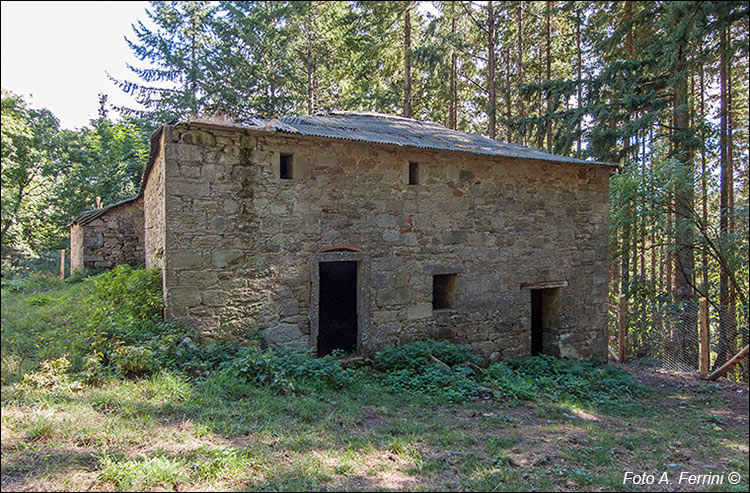Dal Varco di Anciolina a Badia Santa Trinita
itinerario da Pontenano all'abbazia benedettina di Santa Trinita e al Varco di Anciolina
Italiano
NATURA E STORIA PRESSO BADIA SANTA TRINITA 26
Giunti in cima alla salita, la prima costruzione che vediamo è questa grande casa. Vi risiedeva il contadino della Badia nel periodo che il luogo appartenne ai Cassi. L'ultimo fu Adone di Pontenano che abitò a Santa Trinita fino al 1954. In precedenza, invece, fu la Famiglia Detti ad abitare in questo luogo. Arrivava addirittura da Compito (paese tra Chiusi della Verna e Pieve Santo Stefano) Vi risiedettero nel periodo della seconda guerra mondiale e negli anni appena successivi. La casa ospitava anche gli operai che lavorano nei boschi pertinenti all'ex abbazia. Una proprietà di cinquecento ettari che si estendeva fino alla Cima Bottigliana sul crinale del Pratomagno. Questi operari abitavano a Talla, Capraia, Pontenano, Pieve Pontenano, Faltona, Carda, Calleta. Come norma arrivavano a piedi il lunedì mattina di buon'ora e ripartivano il sabato pomeriggio.
I fondi dell'edificio erano adibiti a stalle, un buon riscaldamento per il piano superiore.
Escluso il periodo invernale, la grande cucina di questa casa, generalmente un sabato sera ogni mese, si trasformava in sala da ballo. Arrivavano persone dagli stessi paesi elencati sopra. Al suono di un mandolino e di una fisarmonica si dava vita a piacevoli serate danzanti, ma anche a qualche scaramuccia che scaturivano generalmente per gelosie tra giovani di paesi diversi.
I proprietari del luogo, i Cassi, che lo avevano acquistato intorno alla metà del XIX secolo, risiedevano in quella che a suo tempo era stata la parte del monastero abitata dai monaci a cui si poteva accedere direttamente dall'interno della chiesa. L'ultimo proprietario privato di Badia Santa Trinita e dei tanti terreni adiacenti fu Giovanni Cassi che vendette l'intera proprietà al Demanio dello Stato nel 1959.
Once you reach the top of the road, the first building you see is this large house. The farmer from the Badia lived there during the time the place belonged to the Cassi family. The last was Adone di Pontenano who lived in Santa Trinita until 1954. Previously, however, it was the Detti family who lived in this place. They even came from Compito (a town between Chiusi della Verna and Pieve Santo Stefano). They lived there during the Second World War and in the years immediately following. The house also housed the workers who worked in the woods belonging to the former abbey. A property of five hundred hectares that extended up to Cima Bottigliana on the Pratomagno ridge. These workers lived in Talla, Capraia, Pontenano, Pieve Pontenano, Faltona, Carda, Calleta. As a rule, they arrived on foot early on Monday morning and left on Saturday afternoon.
The bottom of the building was used as stables, a good heating for the upper floor.
Except for the winter period, the large kitchen of this house, generally one Saturday evening every month, was transformed into a dance hall. People would come from the same villages listed above. To the sound of a mandolin and an accordion, pleasant dancing evenings would take place, but also some skirmishes that generally arose from jealousy between young people from different villages.
The owners of the place, the Cassi family, who had purchased it around the middle of the 19th century, lived in what had once been the part of the monastery inhabited by the monks and which could be accessed directly from inside the church. The last private owner of Badia Santa Trinita and the many adjacent lands was Giovanni Cassi who sold the entire property to the State Property Office in 1959.























































































